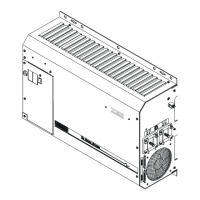APPENDIX
Page
128
Copyright Trace Engineering Company, Inc.
5916 - 195th Street N.E.
Arlington, WA 98223
Telephone: 360/435-8826
Fax: 360/435-2229
www.traceengineering.com
PS Series Inverter/Charger
Part No. 3597
Rev. D: November 23, 1999
RC8 REMOTE CONTROL
The optional RC8 remote control provides an LED status of the inverter and duplicates the Power On/Off
Switch on the PS Series Inverter/Charger. It connects directly to the port labeled RC8 on the AC board
located under the top cover access panel (see page 13 for the location).
PSCB CONDUIT BOX
The PSCB conduit box consists of a metal enclosure for connection to the PS Series Inverter/Charger
and is provided to meet applicable codes and safety standards. The PSCB is fitted to the AC or DC side
of the PS Series Inverter/Charger and has ½”, ¾” and 2” knockouts for attaching conduit hardware.
GEN RELAY MODULE
The GEN RELAY MODULE provides two relays (RY7 and RY8) that allows starting and stopping of both
Honda and Onan type generators and an AC output fault relay (RY11) that engages when there is no AC
voltage on the output.
The voltage settings that control relays RY7, RY8 and RY11 can be individually adjusted using the SWRC
or SWCA. The terminals that are used to connect the external wiring and the COM (common) terminals of
the relays are separated and both the N.O. (normally open) and N.C. (normally closed) contacts of the
relays are provided.
It is much simpler to make the connections to the generator if a remote control terminal or connector is
available on the generator. This sometimes requires that the generator’s optional remote control be
purchased. This allows examination of how the generator remote control works - which is what the
inverter’s generator start system in the inverter must duplicate.
Connection of the GEN RELAY MODULE to the generator remote control also eliminates the need to
modify the generator and violate the warranty of the generator.
All wiring connected to the generator should be fused if any voltage is present at the point of connection.
If in doubt, add a fuse. These relays are not intended to directly control the starter motor or operate the
ignition system - rather they can be used to send a signal or operate the coil of another higher amperage
device which does the actual switching of the power. The relays must be fused to prevent damage if they
are miswired or a short-circuit occurs. The maximum fuse size must not exceed 5 amps. Fuses should be
located as close as possible to the point of connection to the larger conductors that are providing power
from the battery. You should also add a switch to allow disabling of the automatic generator start system
at the generator. This will allow local control of the generator, preventing starting while servicing, etc.
Available for purchase in 2000 (2nd
quarter).
AUX RELAY MODULE
The AUX RELAY MODULE provides two voltage-controlled relays (RY9 and RY10) and an AC output fault
relay (RY11). Relays RY9 and RY10 can perform battery voltage related tasks to simplify installations and
relay RY11 engages when there is no AC voltage on the output.
The voltage settings that control relays RY9, RY10 and RY11 can be individually adjusted using the
SWRC or SWCA. The terminals that are used to connect the external wiring and the COM (common)
terminals of the relays are separated and both the N.O. (normally open) and N.C. (normally closed)
contacts of the relays are provided.
The AUX RELAY MODULE is connected to the PS Series Inverter/Charger via the RJ11 jack located on
the AC board located under the AC access cover (see page 13 for the location of the AUX RELAY
MODULE connection). These relays are single pole double throw, five amp relays and are not intended to
directly control the power sources or loads - rather they can be used to send a signal or operate the coil
of another higher amperage device which does the actual switching of the power. The relays must be
fused to prevent damage if they are miswired or a short-circuit occurs. The maximum fuse size must not
exceed 5 amps. Fuses should be located as close as possible to the point of power from the battery.
Available for purchase in 2000 (2nd
quarter).

